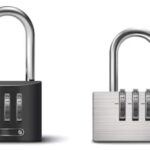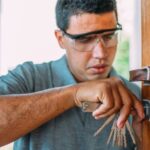We believe that knowledge is the key to better security. Understanding parts of a lock can help you make rational decisions for your home’s security. We have been using locks for years now. On doors, cabinets, cupboards, everywhere! But, have the though ever crossed your mind about how exactly the door lock mechanism works? If yes, then by the end of this blog, you’ll get the answer. We’ll explain the components of various types of door locks, explain how they work, and offer insights into choosing the right lock for your needs.
Introduction to Door Locks
Door locks are the first line of defense in home security. These devices are used to keep your door locked with a key. They’ve been around for thousands of years, evolving from simple wooden mechanisms to the complex systems we use today. At their core, all door locks serve the same purpose: to secure an entrance and control who can access it.
Types of Door Locks
There are many varieties of door and lock parts. In this wide range, we open some with a key or a combination code. Meanwhile, there are other locks that use a more complex mechanism, accessed with fingerprints and iris recognition. Such modern locks are made from all sorts of mechanical and technology-led systems. To give a gist, we are going to discuss some of the common door lock types.
- Cylinder Locks
- Level Locks
- Mechanical Locks
- Electric Locks
- Electronic Locks
- Smart Locks
Each of these locks has different characteristics and functions differently. We are primarily going to break down the mechanism and door lock components of the cylindrical nature, as there is a wide range that we cannot conclude in just one page. Thus, you’ll find us explaining the anatomy of cylinder locks from this point forward.
The Anatomy of Pin Tumbler Lock
Since there are too many variations of locks, we are going to focus on the anatomy of cylinder locks. These are commonly known as the pin tumbler locks, which have been in existence since ancient times. The ones we use today are, of course, based on recent technology designed and developed by Linus Yale Junior in the 1860s. His concept is still very much used in modern cylinder locks today.
These types are the most commonly found locks in residential settings. Therefore, a pin tumbler lock is the standard lock that you are going to find on most home doors. Let’s understand its components.
| Parts of a Lock | Description |
| Cylinder (shell) | The outer casing of the lock.Consists of all the internal components.Usually made of brass or steel for durability. |
| Plug | The cylindrical part that rotates inside the cylinder. Contains the keyway where you insert the key.Turns when the correct key is inserted. |
| Keyway | The slot is the plug where the key is inserted. Shaped to match the key’s profile.Prevent wrong keys from being fully inserted. |
| Pins | The pins are the heart of the locking mechanism. The type includes:Driver Pins:Upper pin that sits in the cylinder. Pushed down by springs.Key Pins:Lower pins that sit in the plug.Come in different lengths to match the key’s cuts. |
| Springs | Small springs that sit above each set of pins.Keep the pins in place when no key is inserted.Provide resistance when a key is inserted or removed. |
| Shear Line | The gap between the cylinder and the plug. When all pins align at this line, the lock can turn. |
| Cam | A rotating piece at the back of the plug.Interacts with the latch or bolt to open the door. |
| Retaining Pin | Holds the plug inside the cylinder.Prevents the lock from being pulled apart. |
How Does a Pin Tumbler Lock Works?
Now that we are all aware of the parts of a lock (cylinder), we can understand its mechanism. To make it simple for you, we have divided the door lock mechanism of the pin tumbler into 4 parts, which are as follows:
- When no key is inserted: The driver pins and key pins straddle the shear line. This prevents the plug from rotating.
- Inserting the correct key: The key’s grooves push the key pins upward. this, in turn, pushes the driver pins up. When the key is fully inserted, all pins align at the shear line.
- Turning the key: With all pins aligned, the plug can rotate. The cam at the back of the plug turns. This moves the latch or bolt, opening the door.
- Removing the key: Springs pushes the pins back down, and the lock returns to its secure state.
Other Common Lock Components
While we are all focused on the pin tumbler mechanism, there are other door hardware parts you might find in various door locks.
- Deadbolts
- A strong, rectangular bolt that extends into the door frame.
- Operated by a key from the outside, and usually, a thumb turns from the inside.
- Provides additional security beyond the standard latch.
- Strike Plate
- A metal plate is attached to the door frame.
- Receives the latch or deadbolts when the door is closed.
- Reinforce the frame and help distribute the force during a break-in attempt.
- Door Knob
- These are the most common types of door locks that are not recommended for external doors.
- The parts of a door knob include a lever, spindle, strike plate, cylinder, rosette, and faceplate.
- Some people use keyed entry door knobs just to provide added security.
- Faceplate
- The visible part of the lock is on the edge of the door.
- Often decorative but also functional.
- Holds the lock mechanism in pieces within the door.
- Latch
- The spring-loaded bolt that keeps the door closed.
- Retract when the handle is turned or the key is used.
- Less secure than a deadbolt but allows for easy spooning and closing.
Choosing the Right Lock
Going through the anatomy of the door locks can help you choose the right lock for your needs. Still, these are some of the questions you must ask yourself to find the right answers:
- Security Level
How many pins does the lock have? (apparently, it is like more pins = more security). Is there a deadbolt for added protection? These are some things that can help define the security level you’re looking for.
- Convenience
Do you want a traditional key, keypad, or smart lock? The answer lies in who needs access and how often. If it’s for daily needs or the office, you can go for smart locks, as they offer a great level of convenience.
- Durability
Look for locks made with strong materials like brass or steel. Check for anti-pick and anti-drill features, which are best for break-ins and preventing intruders.
- Compatibility
Make sure that the lock fits your door thickness and existing cut spots. If you are thinking of installing smart locks, then check if they are compatible with your home automation system.
- Certifications
Look for locks rated by ANSI, the country’s national standard institution. Grade 1 offers the highest security, followed by Grade 2 and 3.
When to Call KeysnLock Professionals?
There may come a situation when you need professional help to install the door lock of your needs. And that’s when Keysnlock comes into the picture! The following are the services that we provide, performed by seasoned locksmiths!
- Lock replacement or rekeying.
- Dealing with a broken key inside the lock.
- Upgrading to a more secure lock system.
- Installing electronic or more complex lock systems like smart locks.
- Repairing a malfunctioning lock.
At Keysnlock, our team of experienced locksmiths is always ready to help with these and any other lock-related issues. Just give us a call, and we’ll be on our way to unlock the solution.
Commonly Asked Questions
The common parts of a door lock are called cylinder, latch or bolt, strike plate, faceplate, and the knob or lever.
The anatomy of a door has many components that work together to create a perfect mechanism. It includes a cylinder, plug, shell, pins, keyways, cam, shear line, etc.
The most common mechanism includes the key alignment of a series of pins inside the lock. When you insert the right key, pins are lifted to a certain level, rotating the cylinder and unlocking the door.
We install door locks by preparing the door for work, installing the latch & lock mechanism, and placing the strike plate. When it’s done, we test the lock and finalize it.
The loop part of the lock is called the shackle, which remains in the padlock body.
The exterior parts of a door are called a rough opening, panel, frame, side jamb, head jamb, etc.
In such a scenario, you can choose our rekeying services, which change the key without changing the lock itself. Plus, this service is cheaper than getting a new lock.
Modern locks are made using the new technology; they are operated using fingerprints and iris recognition.
Call our experienced locksmiths; they will inspect the problem and provide a solution in an instant. All this is combined with top-notch customer service.
The most common locking mechanism that you find in residential areas as well are cylinder locks. These are also called Pin Tumbler.
Surely! Our experts will also help you choose the right lock for your door, depending on your needs and security preferences.






